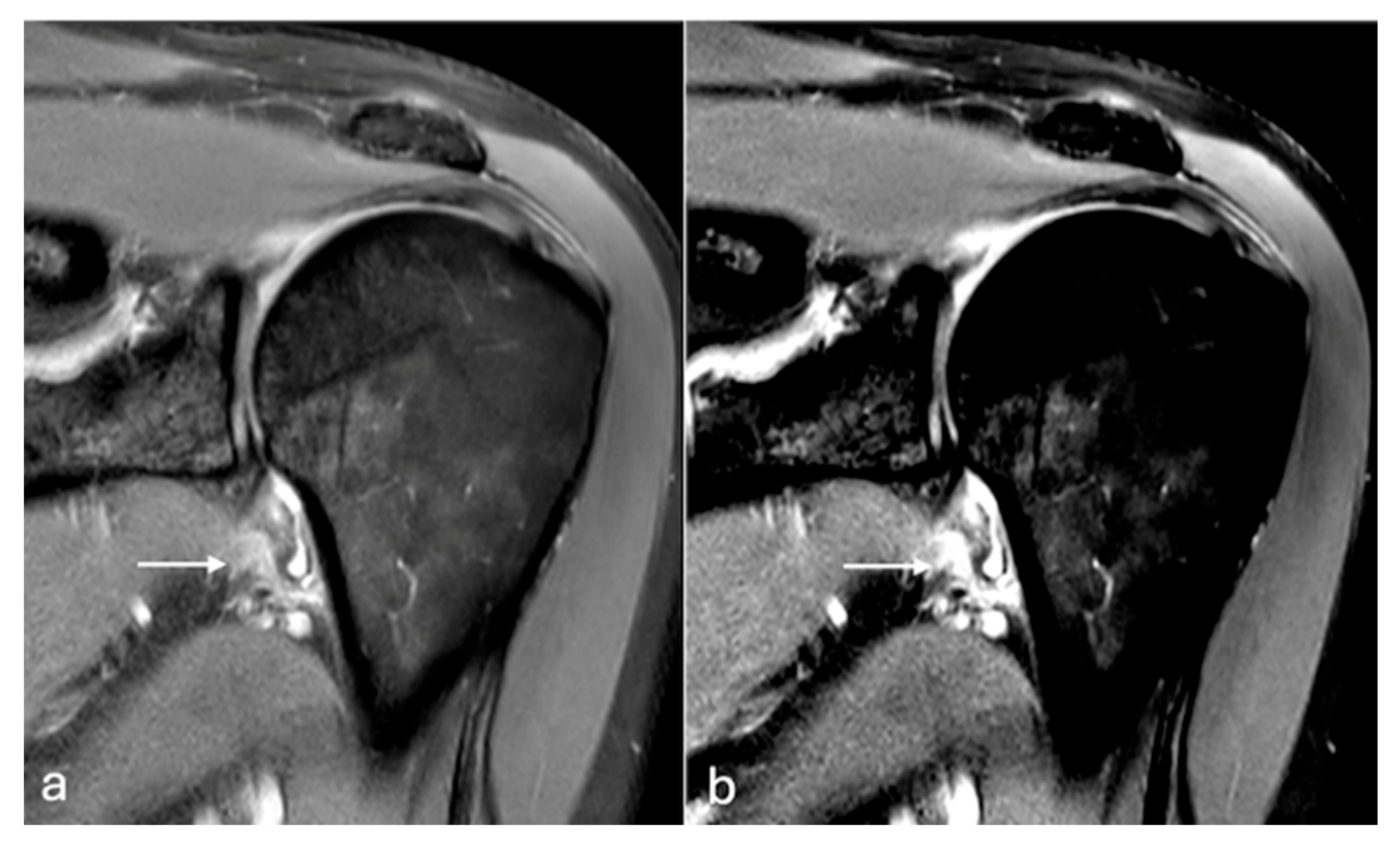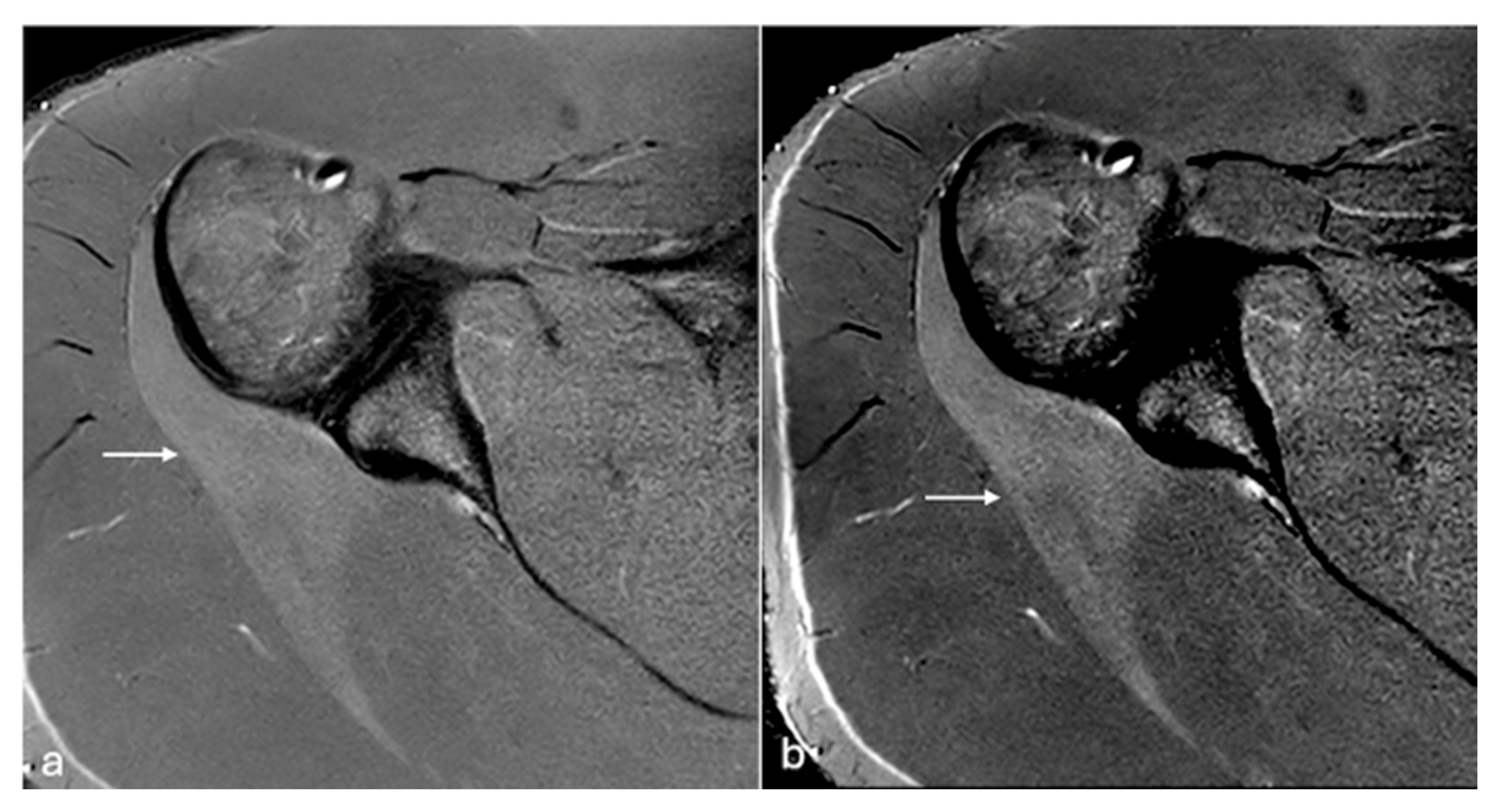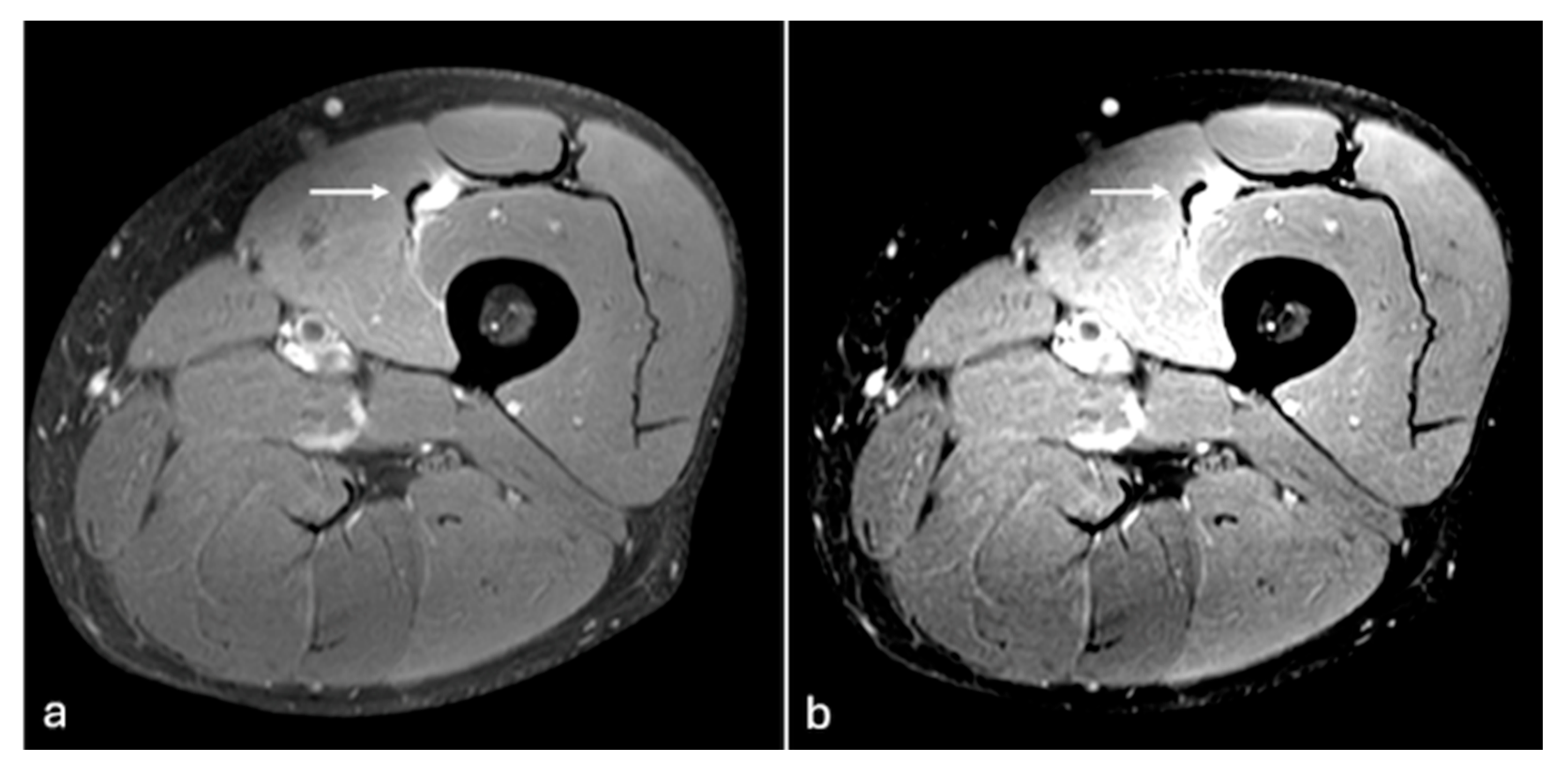1. Introduction
Soft tissue oedema can be either localized or generalized, resulting from an excess of fluid in the interstitial spaces of body tissues. Several conditions, including traumatic, inflammatory, infective, vascular aetiologies, and systemic conditions present with oedema, making it a critical feature for diagnosis. Detailed assessment of soft tissue oedema not only helps in reaching a differential diagnosis and planning treatment strategies but also in follow-up of cases [
1,
2]. Oedema or fluid collections can be seen within the muscles, in intermuscular plane or subcutaneous regions depending on the etiology. The pattern of soft tissue oedema is different in each pathology. The oedema can be myofascial, muscular, or musculotendinous in case of muscles injury. The oedema is centered over the bone muscle interface in patients with contusion injury. In infections, i.e., pyomyositis or necrotizing fasciitis, an abscess with oedema involving multiple muscles can be seen. In patients with compartment syndrome the oedema tends to involve muscles and soft tissues confined to involved compartment with anterior compartment of leg being the commonest site. Denervation pattern of soft tissue oedema involve muscles innervated by the involved nerve. The pattern of soft tissue oedema post radiotherapy is rather diffuse and may have clear demarcation dictated by the radiation field. A varied pattern of oedema can be seen in soft tissue metastasis ranging from diffuse oedema, abscess type, oedema with ossification. Post-traumatic deposition of calcium in soft tissues may present with marked muscle oedema in cases of myositis ossificans. MRI in these cases may be misleading as the small calcium deposits may be masked by the disproportionate oedema. Likewise, calcium deposition in cases of calcific tendinopathy can present with marked oedema in the soft tissues adjacent to involved tendons.
Similarly, osseous oedema can be seen as a plethora of pathologies. Osseous oedema is due to sequela of destruction of fat cells and associated fibrovascular regeneration. Osseous oedema is due to leakage of capillaries, prostaglandins E2 (inflammatory mediators) and impaired vascular drainage. Extent and pattern of oedema can help to differentiate if the process is aggressive or quiescent and benign or malignant. Oedema of soft tissue and bones is commonly seen in infection, i.e., osteomyelitis. The oedema in tumors is centered around the lesion. The extent of osseous oedema around the osseous lesions is classically less in aggressive lesions in comparison to reactive and benign lesions. For instance, oedema in osteoid osteoma, osteoblastoma, and chondroblastoma is disproportionately more in comparison to the size of tumor itself. The same applies in cases of stress fracture, calcific tendinopathy with intraosseous extension, myositis ossificans, and periosteitis ossificans. The same can be applied to see the effect of response to treatment, with resolution of oedema in cases of osteoid osteoma, osteoblastoma, and chondroblastoma, suggesting a response to treatment like radiofrequency ablation, cryotherapy, or surgery.
Imaging plays a crucial role in evaluation of a lesion and adjacent soft tissues. Windowing significantly affects the image quality for depicting pathologies on cross-sectional imaging [
3].
On CT [Computed tomography], standardized windowing techniques are routinely used to emphasize the imaging features of various pathologies. Despite its utility, there is a paucity of literature on optimal window/level settings for effectively assessing changes of oedema on MRI. The effect of windowing/level setting in MRI have not been evaluated before. We analyze the role of windowing/level setting in MRI in plethora of pathologies in this pilot study and review the literature.
2. Methods and Materials
Following local hospital committee ethics approval, a retrospective evaluation of our Radiology Information System and Picture Archiving and Communication System was performed using keywords such as “oedema”, “soft tissue oedema”, and “muscle oedema” for the period from January 2024 to August 2024. These reports were then read to randomly identify fifty patients with various musculoskeletal pathologies showing changes in soft tissue oedema on MRI by a fellowship-trained musculoskeletal radiologist with over 10 years of experience.
Exclusion criteria: Patients who had only osseous oedema were excluded. Patients who did not have fluid-sensitive sequences on MRI were excluded from the study. Additionally, those with history of surgeries and those with artefacts and metal were excluded.
MRI was performed on 3 Tesla Philips Achieva MRI (Philips, Eindhoven, The Netherlands). PD sequences with fat saturation were obtained, with a TE of 30 ms, TR ranging from 2500 to 3500 ms and slice thickness of 3 mm.
Two images of the pathology were taken on this sequence, one using the default windowing with a wider window width compared to the window level, and the other using modified window settings with the window width being narrower than the window level.
2.1. Image Analysis
Two independent musculoskeletal radiologists, ‘Radiologist A’ and ‘Radiologist B’ with 10 years and 2 years of experience, respectively, evaluated both the images for their depiction of pathology as well as image resolution and graded the images on a 5-point Likert scale, coded as follows:
- 1.
Poor quality
- 2.
Fair quality
- 3.
Good quality
- 4.
Very good quality
- 5.
Excellent quality
Differences in interpretation were resolved by consensus. The scores for all the cases were tabulated on Microsoft Excel and analyzed.
2.2. Statistical Analysis
Inter-rater intra-class coefficient (ICC) was calculated for the observed data to assess the inter-rater reliability [
4]. A Shapiro–Wilk test was performed to evaluate whether the data followed a normal distribution [
5]. Friedman’s test was conducted to compare the scores of both images [
6].
3. Results
Images of fifty patients were included for final analysis. The Likert scores for default and modified window settings are summarized in the graph below (
Figure 1).
Both images showed 100 per cent sensitivity in detecting soft tissue oedema [
Figure 1,
Figure 2,
Figure 3,
Figure 4,
Figure 5 and
Figure 6]. The mode value for responses for modified windowing and default windowing technique was ‘4—very good quality’ and ‘3—good quality’, respectively. There are significantly higher ‘excellent quality’ responses for images with modified setting as compared to images with default settings by both the radiologists.
However, images with default window settings were perceived to be of better quality than corresponding images with modified window settings in 10% of cases and in 14% of cases as assessed by Radiologist A and Radiologist B, respectively.
The diagnostic quality of images with default window settings and corresponding images with modified window settings was rated to be alike in 16% of cases and 24% of cases by Radiologist A and Radiologist B, respectively.
Also, there was no ‘fair quality’ response for modified window settings by either radiologist, indicating a shift to higher quality of images compared to default settings.
The inter-rater reliability between both the readers was moderate, with an ICC score of 0.56 for images with default windowing and 0.60 for images with modified windowing.
A Shapiro–Wilk test was conducted to assess the normality of the data. The results showed that the data deviated significantly from a normal distribution, with W = 0.850, p < 0.001 and W = 0.807, p < 0.001 for the scores of images using default settings by ‘Radiologist A’ and ‘Radiologist B’, respectively. For images with modified settings, W = 0.688, p < 0.001 and W = 0.656, p < 0.001 for scores by ‘Radiologist A’ and ‘Radiologist B’, respectively. Given that the p-value is less than 0.05, the null hypothesis of normality was rejected, indicating that the data is not normally distributed.
Hence, Friedman’s test was conducted to compare the scores of both the images. The results indicate a significant effect, with a chi-squared statistic (X2) of 29.538. The sample size was 50, and the p-value obtained was less than 0.00001, indicating a highly significant result. This confirms that modified window settings have significantly outperformed default window settings in perceived quality of images. Modified window setting can help to enhance and augment the abnormality in particular fluid signal change like oedema or hematoma in comparison to traditionally acquired MRI images.
4. Discussion
Soft tissue oedema is a commonly observed finding in diagnostic imaging. The nature of oedema may provide information about the diagnosis, severity of a condition, and potential outcomes for the patient [
7]. It reflects the degree of inflammation and tissue damage and, hence, can guide treatment as well as staging [
8]. It arises in a variety of medical conditions, spanning traumatic, inflammatory, vascular, systemic, and neoplastic causes. It frequently accompanies injuries such as fractures, ligament tears, or surgical trauma [
9]. Vascular issues, including venous insufficiency, deep vein thrombosis, and lymphedema, often result in swelling from oedema, as do systemic illnesses like heart failure, kidney disease, or hypothyroidism [
10]. In muscle denervation, subtle muscle oedema is the only feature seen in the early stages, and it can lead to muscle atrophy if left untreated [
11]. Peritumoral oedema is a common feature, seen in benign or malignant tumors, caused due to compression or invasion of surrounding structures by the tumor and, hence, can guide biopsies for histopathological diagnosis [
12]. In inflammatory conditions such as polymyositis and dermatomyositis, the presence of muscle oedema parallels the disease activity [
13]. Allergic reactions like angioedema and neurological conditions such as peripheral neuropathy also contribute to soft tissue oedema [
14]. However, soft tissue oedema can be an incidental finding in a few cases with varied clinical applications such as in the study by Mallio et al. on posterior subcutaneous oedemas at the level of lumbar spine [
15].
Soft tissue oedema may range from subtle increase in fluid content to pronounced fluid accumulation, depending on the underlying pathology [
16].
While various imaging techniques such as MRI, CT, and ultrasound are employed to evaluate various pathologies with changes of oedema, MRI is the most sensitive to detect oedematous changes in soft tissues as it provides excellent soft tissue contrast [
17].
On MRI, contrast or the differences in signal intensities between anatomical structures and between normal anatomy and pathologies forms the basis for imaging diagnosis. In absence of this contrast, it is not possible to diagnose pathologies [
18].
The MR images usually have a data depth of 12-bits or 4096 intensity levels. Most standard monitors and displays are designed to handle images with 8-bits depth or 256 intensity levels [
19]. To suit the imaging displays, 12-bit images are converted to 8-bit images by remapping the pixel intensity range of the MR image. This typical remapping process is known as ‘windowing’ [
20]. Windowing is the most commonly used image processing operation in digital diagnostic imaging [
21].
On CT, standard windowing parameters have been proposed and are routinely in use to assess the various pathologies [
22]. There are several studies on the significant impact of windowing in improving the accuracy of CT. For example, Arsava et al. showed narrower window width settings significantly improved the accuracy of Alberta Stroke Program Early Computed Tomography Scoring (ASPECTS) performed on non-contrast CT and CT angiography imaging in 44 patients [
23].
In contrast, MR imaging lacks standardized windowing parameters for the evaluating of common pathologies in clinical practice.
The windowing process in MRI allows us to set a level and a window width for those gray values that we want to visualize. It involves mapping the pixel signal intensity from the selected subrange of signal intensities [y
c − y
w, y
c- + y
w]. y
c represents the ‘window level’ (WL) whereas y
w represents the ‘window width’ (WW) [
24]. By definition, the range of the numbers in the image is the window width, and the center of the range is defined as the window level. Values outside the subrange are either black (left side of the window) or white (right side of the window). Only values inside the defined range are placed into the grayscale, allowing focus on specific tissue contrast [
25].
The window width controls image contrast, and the window level controls the brightness of the image. While a narrow window width provides improved image contrast, a wider window width will show an image with less contrast by spreading out the intensity values (
Figure 7). On the other hand, when the window level is increased, the image becomes darker, focusing more on mid-range or darker intensities [
25,
26].
Having this flexibility in visualization allows the radiologist to optimize the windowing settings of the image for viewing a particular region. There is not only one window/level setting used for the analysis rather it is a wide range.
Improper adjustment of these parameters can affect the diagnostic value of the MR image and may conceal valuable diagnostic information [
27].
Recognizing the importance of this process, several studies have been conducted to predict the optimal adjustment of these two parameters. Several techniques using advanced operations have been developed for automatically adjusting these windowing parameters of images in diagnostic imaging [
27,
28,
29].
For example, the deep neural networks, which had success in massive engineering technologies, are being used for adaptive intensity windowing in magnetic resonance imaging [
30].
However, automatic adjustment of these two parameters is usually a complicated problem for various objective or/and subjective reasons, such as the computational complexity, quality, and diversity of data set, spatial distribution of pixel intensity, different image types, individual differences in human experts, and varying observation conditions [
20,
24].
In clinical practice, medical imaging software allows one to easily adjust the window level for the best contrast, often performed by moving the pressed cursor in different directions.
This simpler process, although effective, has its limitations. The values that radiologists may choose for windowing are often unstable as they depend heavily on individual preferences, observer experience, and the specific viewing conditions at the time of analysis [
31]. This can lead to inconsistencies in how images are interpreted across different observers or sessions, which can affect diagnostic reliability. Our study aimed to standardize the window width/window level ratios for assessing soft tissue oedema on MRI.
It involved changing the window width/window level from its default wider window width/narrower window level to narrower width/wider window level. A narrower window width narrows down the range the signal intensities displayed, while the broader window level shifts the grayscale towards a broader central intensity, ensuring that darker and brighter areas are better balanced [
25,
26]. This to decipher subtle variations in tissue density, such as those associated with oedema.
Soft tissue oedemas are usually evaluated on fluid sensitive sequences- either images with chemically selective fat suppression or STIR sequences. On both these sequences soft tissue oedema appears as high signal intensity.
On PDW sequence with fat suppression of MRI, the window width is more than the window level as a default setting. This study assessed the impact of changing the window width/window level from its default wider width/narrower level to a modified narrower width/wider level.
The results of our study align with the hypothesis that windowing adjustments, with a narrowed window width to a wider window level added significant value to diagnostic imaging by effectively visualizing and distinguishing oedema changes.
Our study yielded significant findings that could potentially influence the diagnostic approach in evaluating soft tissue oedema. Utilizing this simple approach is valuable for identifying subtle early signs of oedema that might otherwise be overlooked unless effectively highlighted.
Our study had few limitations. This was a retrospective pilot study and involved patients with soft tissue oedema alone. The numbers were relatively low, limiting the generalization of the results of the study. The spectrum of cases included in this study was also limited by number and confined to musculoskeletal radiology. Observer variability is another limitation, as the assessment of image quality and diagnostic accuracy is influenced by individual radiologist preferences, experience, and subjective interpretation. The default window settings of different vendors may vary from one another and have not been evaluated in our study.












